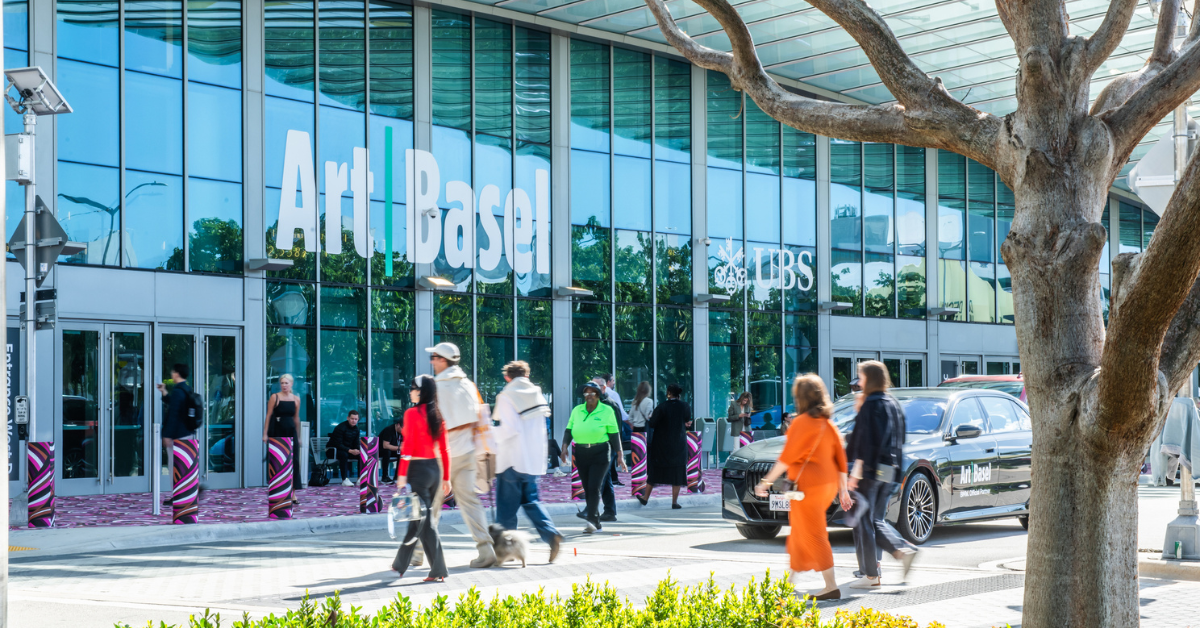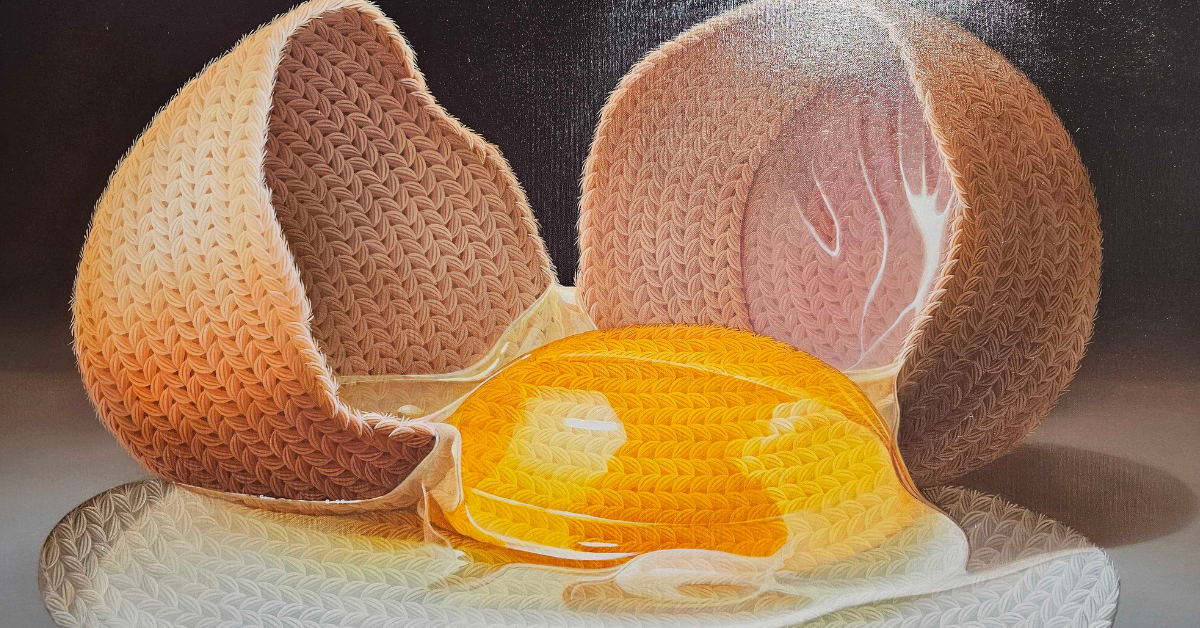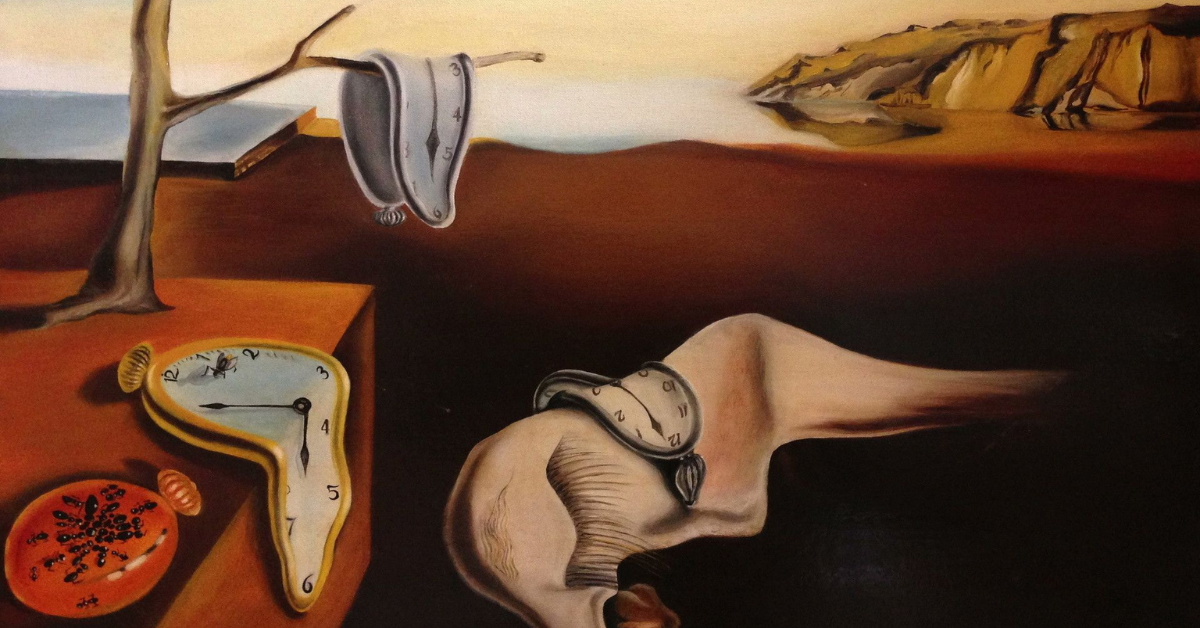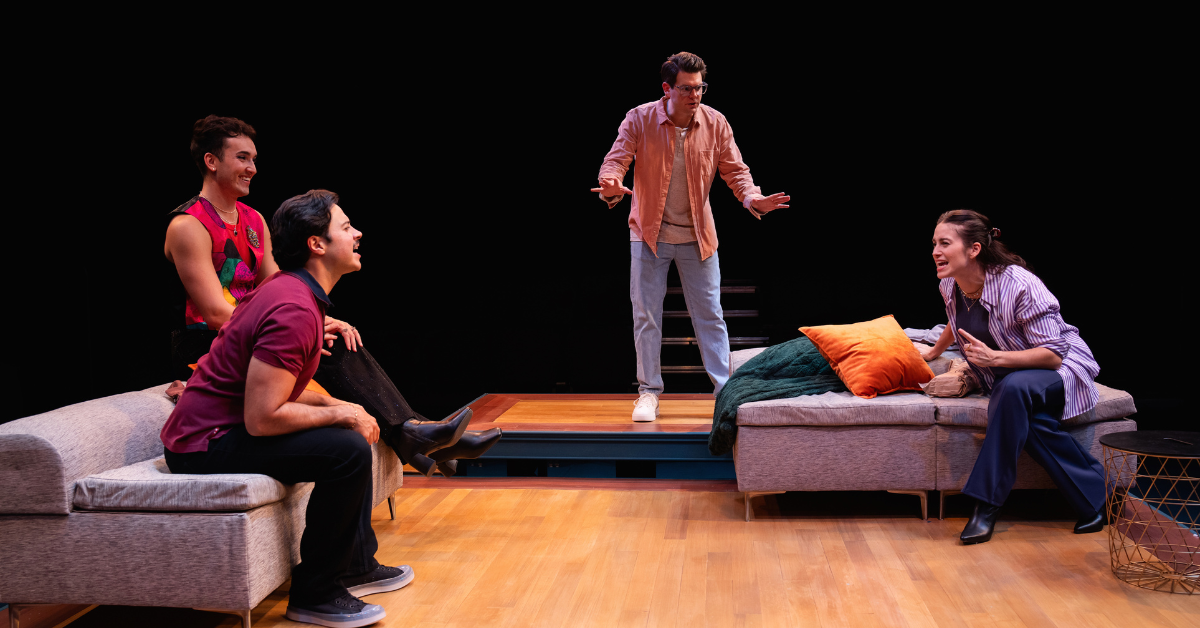Miami’s Art Deco Legacy: A Deep Dive into Its History, Architecture, and Iconic Landmarks
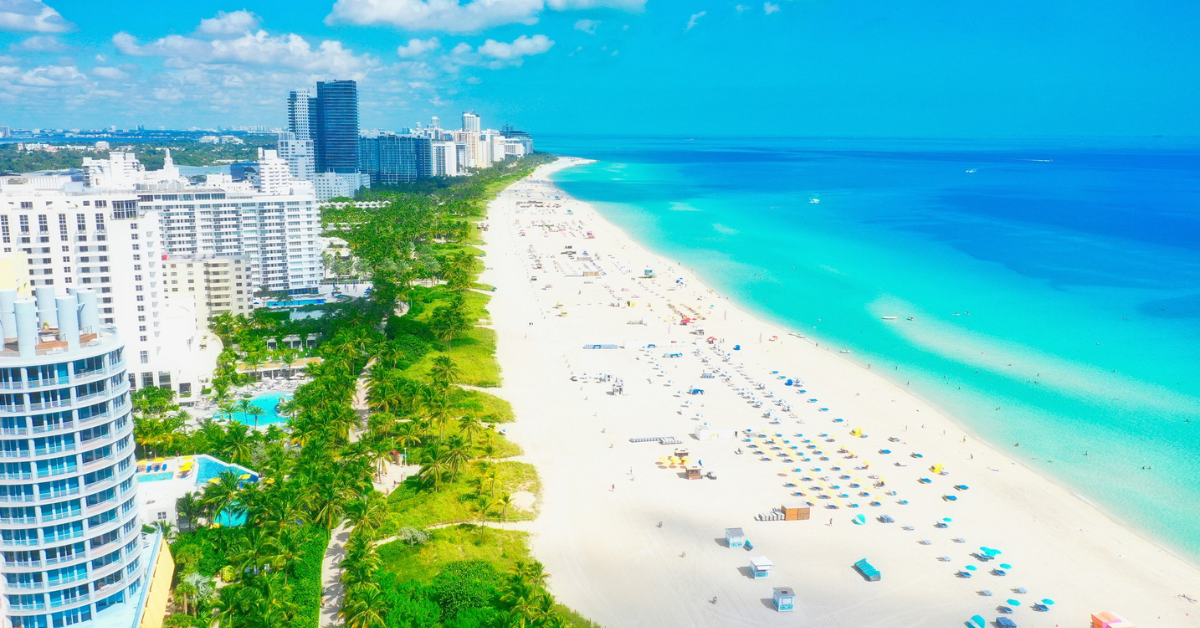
The Rise of Art Deco in Miami Beach
Art Deco emerged in the 1920s and 1930s, an era of rapid industrial progress and social change following World War I. The movement originated in France, debuting at the 1925 Exposition Internationale des Arts Décoratifs et Industriels Modernes (hence the name Art Deco). Characterized by bold geometric patterns, streamlined forms, and rich ornamentation, Art Deco reflected the era’s fascination with modernity and luxury. Cities like New York, Paris, and Chicago embraced it in their skyscrapers and civic buildings, incorporating chrome, glass, and intricate bas-reliefs into their designs.
Miami, however, took a different approach. While cities like New York used dark, dramatic tones, Miami’s version of Art Deco—known as Tropical Deco—embraced pastel colors, curved edges, and nautical themes. This style was perfectly suited to Miami’s coastal landscape, blending futuristic aesthetics with the laid-back, sun-soaked atmosphere of South Beach.
By the late 1930s and early 1940s, Miami Beach was booming with hundreds of Art Deco hotels, theaters, and apartment buildings, designed by architects like Henry Hohauser and L. Murray Dixon. These structures featured elements like porthole windows, terrazzo floors, chrome railings, and aerodynamic curves, often inspired by the luxury cruise liners that docked in Miami.
However, by the 1970s, much of Miami Beach’s Art Deco heritage was in danger. Developers wanted to tear down these pastel-colored buildings in favor of high-rise condos. That’s when the Miami Design Preservation League (MDPL) stepped in. Led by Barbara Baer Capitman, the MDPL fought to protect Miami’s unique architectural legacy, ensuring that South Beach’s Art Deco District remains one of the most well-preserved in the world today.
Where to Experience Miami’s Art Deco Magic
If you want to immerse yourself in Miami’s Art Deco scene, here’s where to start:
- Lummus Park: A picture-perfect spot where Ocean Drive’s iconic Art Deco skyline meets the Atlantic Ocean.
- Lincoln Road: Miami Beach’s pedestrian-friendly shopping and dining promenade lined with Deco details.
- Art Deco Welcome Center (1001 Ocean Drive): Home to expert-led walking tours, deep-dive exhibits, and rich historical insights into the city’s Deco past.
Art Deco Weekend: Miami Beach’s Celebration of Deco Architecture
Every January, Miami Beach transforms into a living, breathing Art Deco time capsule with the Art Deco Weekend festival, a three-day, free celebration of architecture, history, and culture. Hosted by the Miami Design Preservation League (MDPL), this festival takes over Ocean Drive, offering a jam-packed lineup of events.
What to Expect at Art Deco Weekend
- Guided Walking Tours: Get exclusive insights into Miami’s most famous buildings and the history behind their timeless designs.
- Classic Car Show: Admire a stunning lineup of vintage automobiles parked in front of pastel-colored Deco hotels.
- Live Music & Entertainment: Everything from 1920s jazz bands to modern artists celebrating Deco-era sounds.
- Expo Metro Deco Art Trains: A moving digital art gallery, displaying works from international artists on billboards along Ocean Drive.
- Antique & Vintage Market: Shop one-of-a-kind fashion, furniture, and collectibles inspired by the Art Deco era.
Iconic Art Deco Buildings & Their Hidden Histories
Miami’s Art Deco architecture isn’t just eye candy—it holds incredible stories of Hollywood legends, historic transformations, and hidden cultural gems. Here’s a deeper dive into 20 of Miami’s most iconic Art Deco buildings and the fascinating history behind them.
1. The Colony Theatre (1935) - 1040 Lincoln Road
This Lincoln Road landmark started as a glamorous movie house and later became the home of the Miami City Ballet before transforming into a vibrant performing arts venue. Built in 1935, The Colony Theater’s glowing neon marquee and symmetrical Art Deco facade have made it one of Miami Beach’s most beloved architectural gems. Inside, its intricate moldings and vintage decor transport visitors to a bygone era of cinematic elegance. Now, it hosts everything from film festivals to contemporary theater productions, continuing its role as a cultural beacon in the city.
Today, the Colony Theater is home to Miami New Drama, an award-winning theater company known for its bold, thought-provoking productions that reflect the diverse cultural landscape of Miami. From original works to reimagined classics, Miami New Drama brings world-class storytelling to this historic stage, ensuring the Colony remains a cultural beacon for both locals and visitors alike.
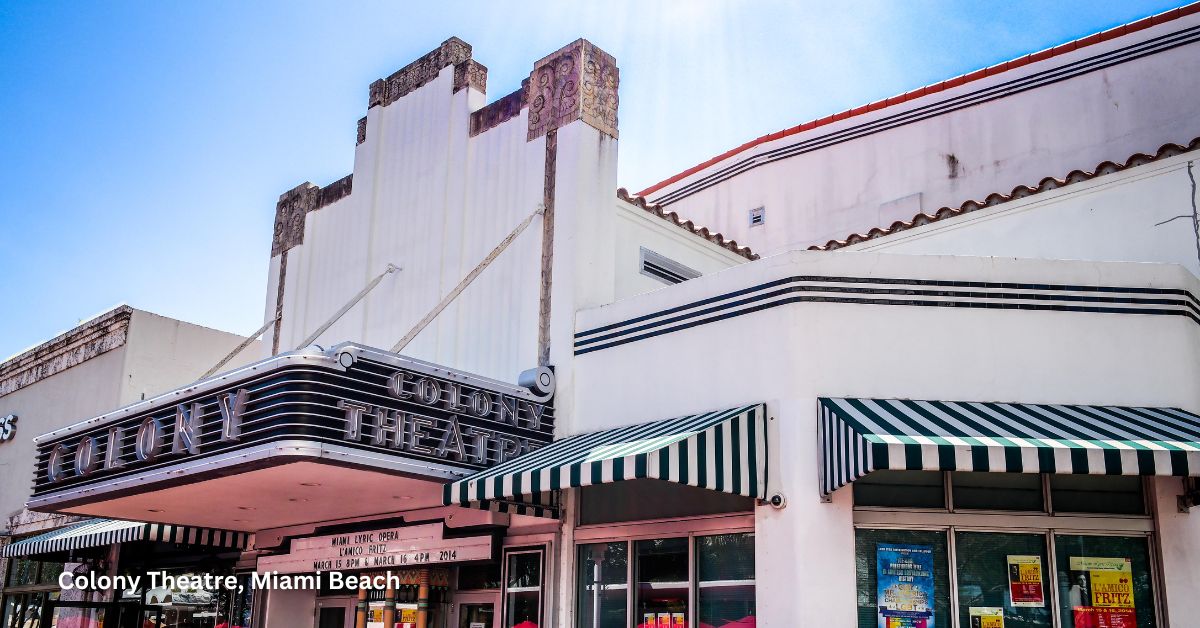
2. The Fillmore Miami Beach at the Jackie Gleason Theater (1950) - 1700 Washington Avenue
A true icon of Miami Beach’s entertainment history, The Fillmore started as the Miami Beach Auditorium, a glamorous venue that hosted everything from boxing matches to Broadway-style performances. In the 1960s, it became the home of The Jackie Gleason Show, turning Miami Beach into the epicenter of television comedy as Gleason famously signed off each episode with, “From the sun and fun capital of the world, Miami Beach!” Its tiered neon marquee and streamlined facade make it a shining example of Deco-era theater design. Over the years, it has welcomed legends like Frank Sinatra and The Rolling Stones, keeping its legacy alive as a top concert destination. Today, it remains a cultural hub, blending historic charm with a cutting-edge live music experience.
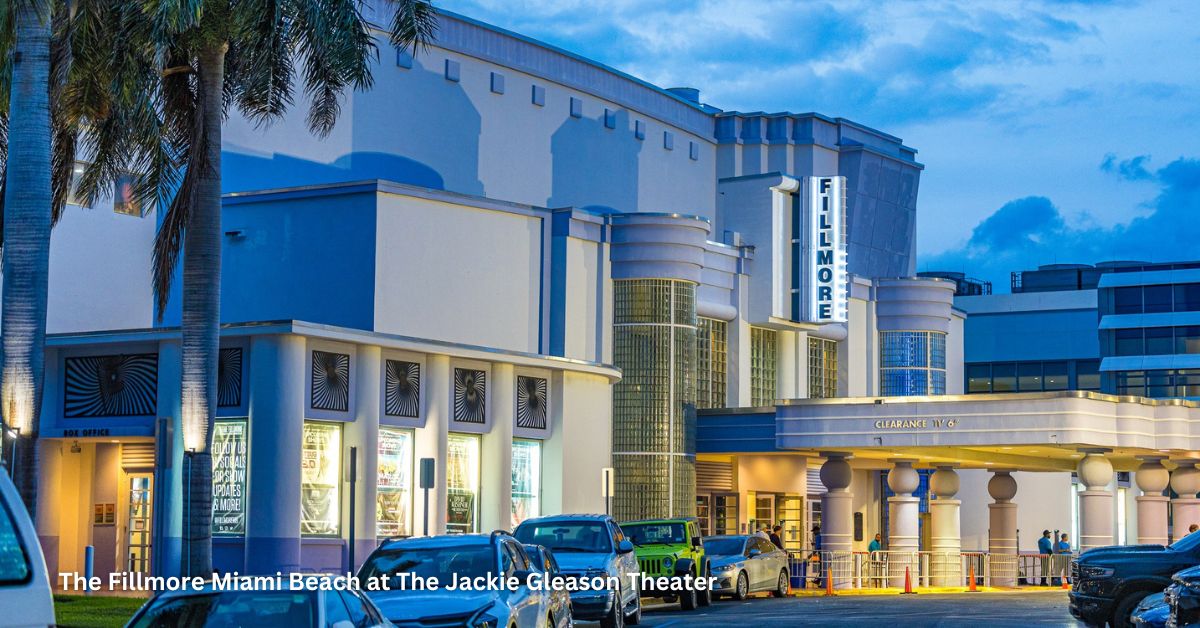
3. The Wolfsonian-FIU (1927) - 1001 Washington Avenue
More than just a museum, The Wolfsonian-FIU is a cultural powerhouse that explores how design shaped modern life. Housed in a striking Art Deco building, its industrial-inspired bas-reliefs and bold geometric patterns reflect Miami’s distinctive architectural style. Originally built as a storage facility, the building was later purchased by Mickey Wolfson to house his vast personal collection of Deco-era artifacts, propaganda, furniture, and graphic design. Over time, it evolved into one of Miami’s premier institutions for art, design, and history, offering thought-provoking exhibitions that highlight the intersection of creativity, politics, and technology. Today, The Wolfsonian-FIU continues to serve as a hub for scholars, artists, and design enthusiasts, preserving and showcasing the innovations that defined the modern age.
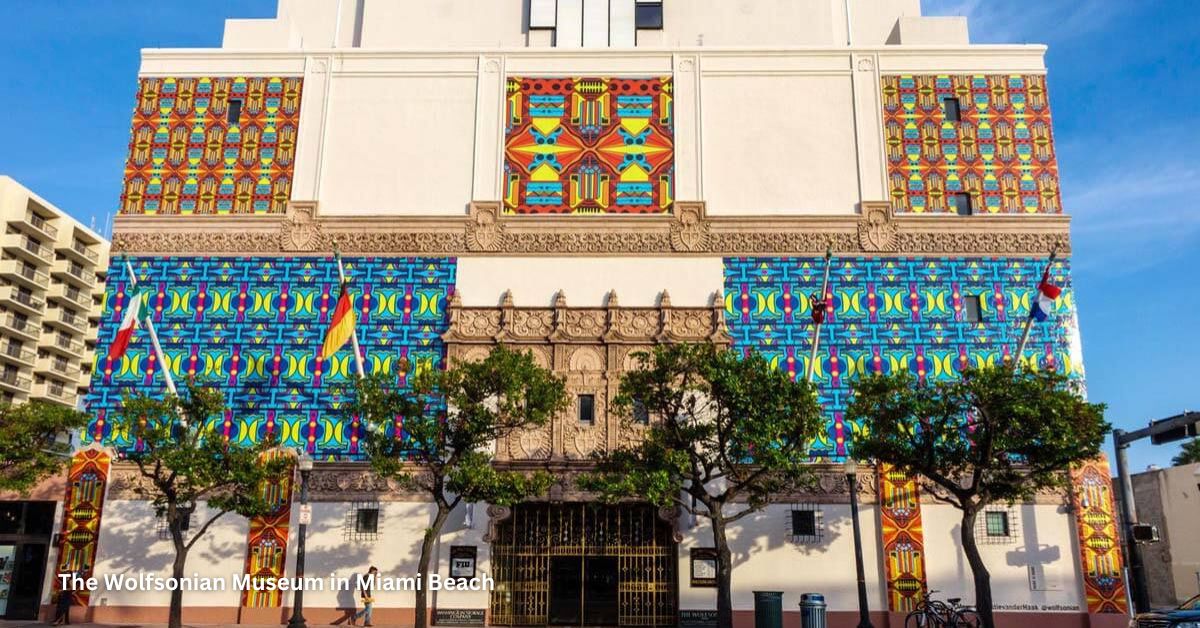
4. Cardozo Hotel (1939) - 1300 Ocean Drive
Owned by Gloria and Emilio Estefan, Cardozo South Beach underwent a $15 million restoration that preserved its 1930s aesthetic while adding modern touches. The hotel features rounded corners, a clean white exterior, and intricate bas-relief details, embodying the refined elegance of Miami’s Deco era. Cardozo has been featured in films such as There’s Something About Mary and Marley & Me, cementing its place in Miami’s pop culture history. Its neon glow at night and prime location on Ocean Drive make it one of the most visually striking buildings in South Beach.
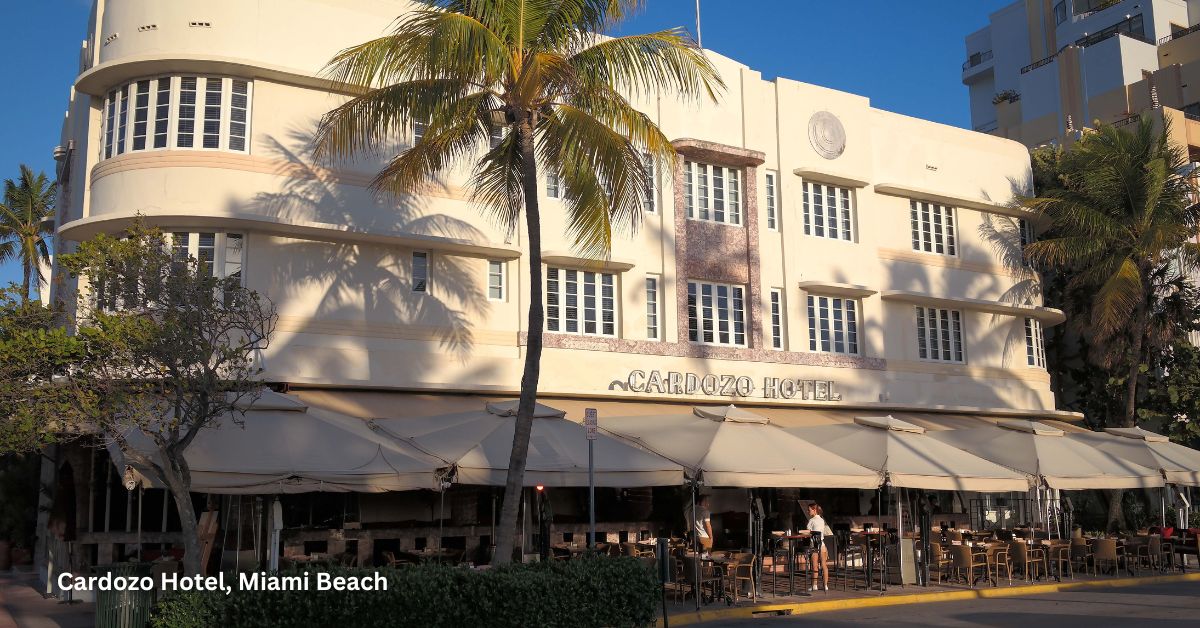
5. Miami Beach Post Office (1937) - 1300 Washington Avenue
One of Miami Beach’s most unique Art Deco landmarks, the Miami Beach U.S. Post Office blends Deco design with classical grandeur. Built in 1937, its curved facade, central rotunda, and geometric bas-reliefs give it a sleek yet imposing presence. Inside, the building is a time capsule of New Deal-era artistry, featuring a striking starburst ceiling and murals depicting Florida’s early settlers and Native American history. More than just a place to send mail, this post office stands as a testament to how Art Deco influenced civic architecture, proving that even functional buildings could be stunning works of art.
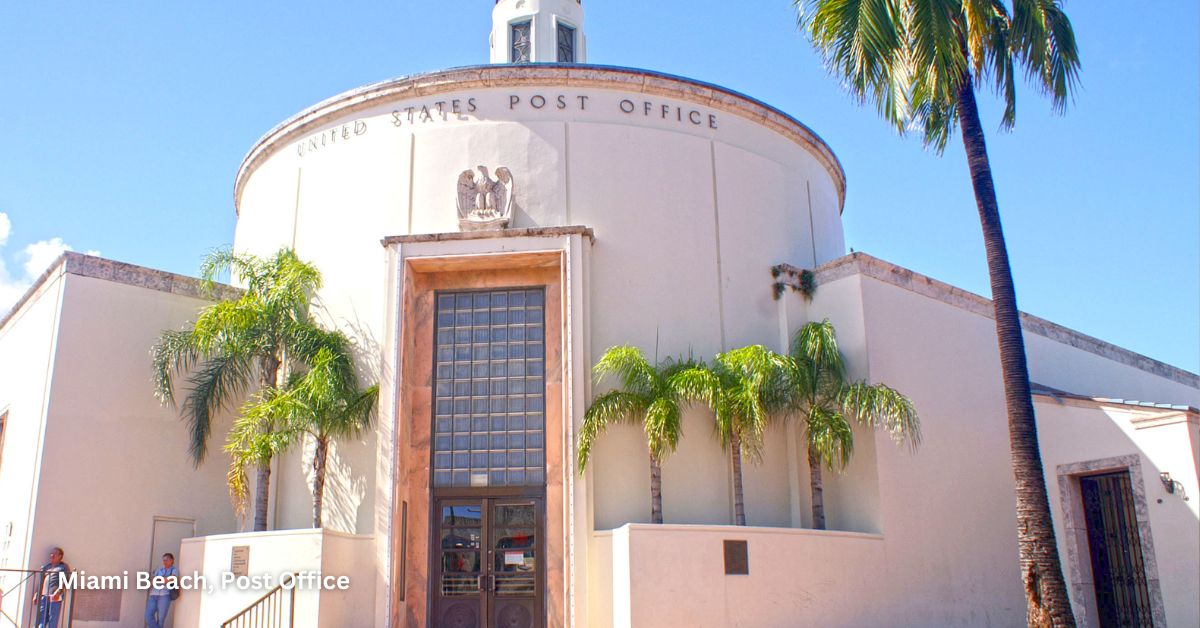
6. The Betsy Hotel (1942) - 1440 Ocean Drive
Unlike most Miami Beach Art Deco hotels, The Betsy features a unique combination of Deco and Colonial Revival influences, giving it a more refined, elegant feel. The large portico and symmetrical facade distinguish it from its more futuristic-looking neighbors, yet it still embodies Miami’s signature architectural charm. The hotel is known for hosting literary events and cultural programs, making it a hub for Miami’s creative community. Its location at the quieter end of Ocean Drive offers a more relaxed, sophisticated Deco experience.
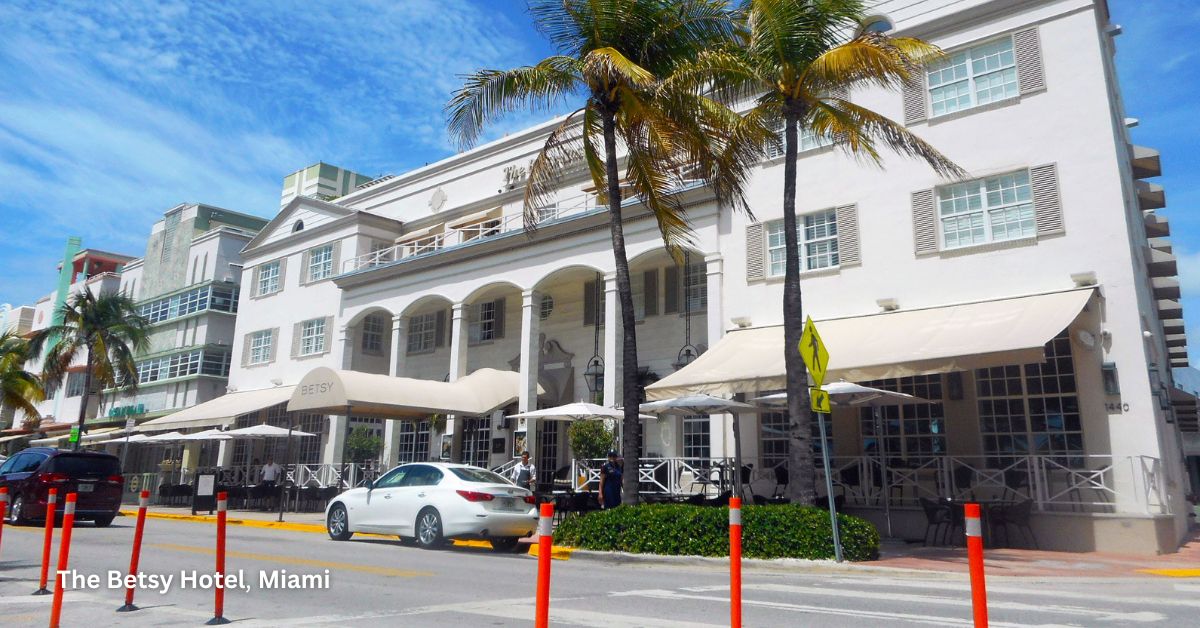
7. The Dupont Building (1939) - 169 East Flagler Street
Not located on the beach but equally iconic, the Alfred I. duPont Building stands as one of downtown Miami’s finest examples of Art Deco meets industrial elegance. Originally built as a financial fortress lined with towering bank vaults and terrazzo floors, this former headquarters for Florida National Bank quickly became a symbol of Miami’s economic rise in the late 1930s. Today, its ornate lobby, gold-accented ceilings, and lavish ballrooms make it one of the city’s most sought-after event venues. From historic glamour to modern luxury, the duPont Building preserves its Art Deco grandeur while hosting some of Miami’s most extravagant weddings, galas, and film shoots.
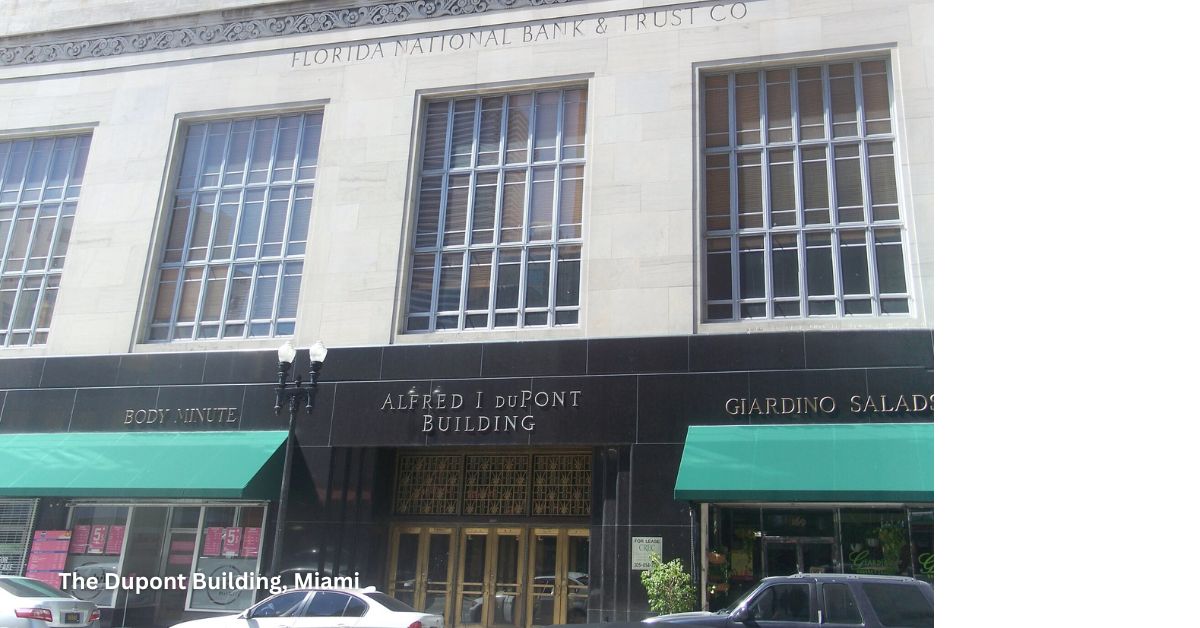
8. The Webster Miami (1939)
The Webster is a testament to how Art Deco and high fashion intersect, originally built as a hotel but later transformed into a luxury boutique that embodies Miami’s artistic heritage. Designed by Henry Hohauser, the building is a masterclass in Deco symmetry, featuring geometric patterns, soft pastel hues, and signature terrazzo flooring. While today it houses Parisian couture and cutting-edge fashion, The Webster’s original neon-lit signage and sleek streamlined form make it an architectural relic of the 1930s. Inside, its original terrazzo flooring and period-specific fixtures remain untouched, preserving the artistic elegance that defined Miami Beach’s Deco era. This blend of history and haute couture makes The Webster a must-visit for architecture lovers and fashion enthusiasts alike.
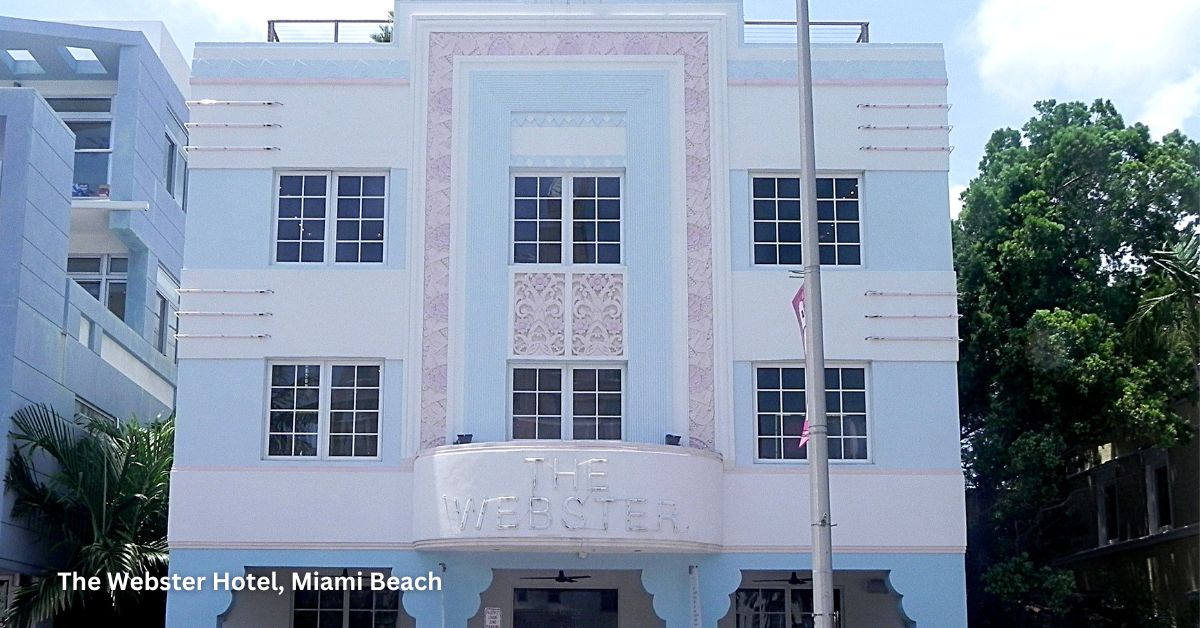
9. The Carlyle Hotel (1939) - 1250 Ocean Drive
The Carlyle is a Miami Beach Deco icon, instantly recognizable for its curved edges, dramatic vertical piers, and signature visor-like sunshades. The hotel has a long history in pop culture, serving as a backdrop in films such as The Birdcage, Scarface, and Bad Boys II. Its strong horizontal lines and uninterrupted symmetry make it a textbook example of streamlined Deco architecture. The building’s timeless aesthetic and prime location on Ocean Drive continue to draw architecture buffs, photographers, and film enthusiasts.
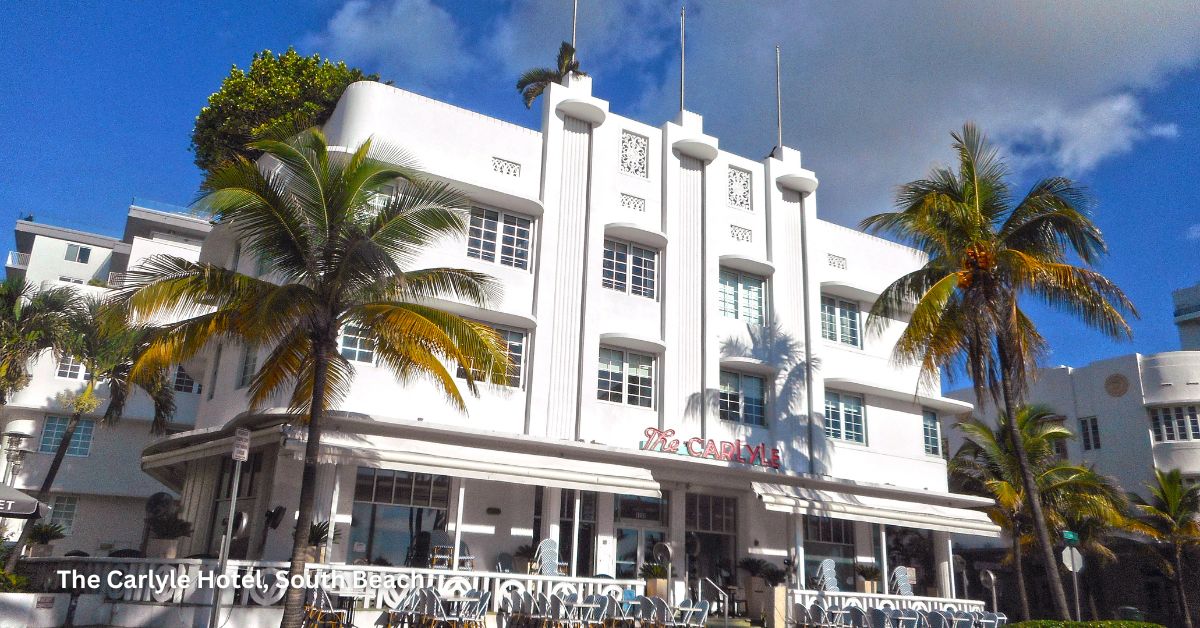
10. Essex House Hotel (1938) - 1001 Collins Avenue
A standout among Henry Hohauser’s many Art Deco masterpieces, The Essex House is a prime example of Nautical Moderne, a variation of Art Deco that incorporates maritime elements. The hotel’s porthole windows, streamlined curves, and smokestack-inspired neon tower make it resemble an ocean liner. Though smaller in scale compared to some other Ocean Drive hotels, Essex House perfectly encapsulates the sleek, aerodynamic feel of 1930s Deco design.
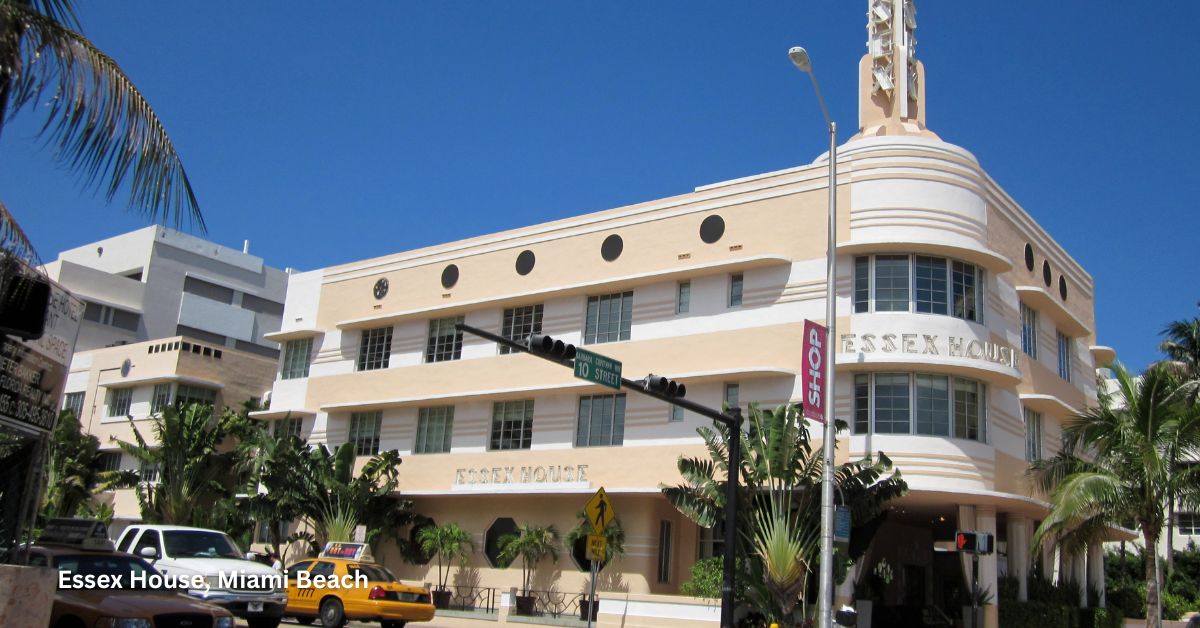
11. The Tides (1936) – 1220 Ocean Drive
Designed by L. Murray Dixon, The Tides was once dubbed the "Queen of Ocean Drive" for its height and grandeur, standing at 12 stories tall, making it one of the tallest Art Deco hotels in Miami Beach. Its symmetrical design, nautical porthole windows, and streamlined facade make it an architectural gem. The hotel was a favorite of celebrities in the 1930s and 1940s, drawn to its oceanfront location and sophisticated ambiance. While it’s temporarily closed, The Tides remains one of the most elegant Deco buildings in South Beach.
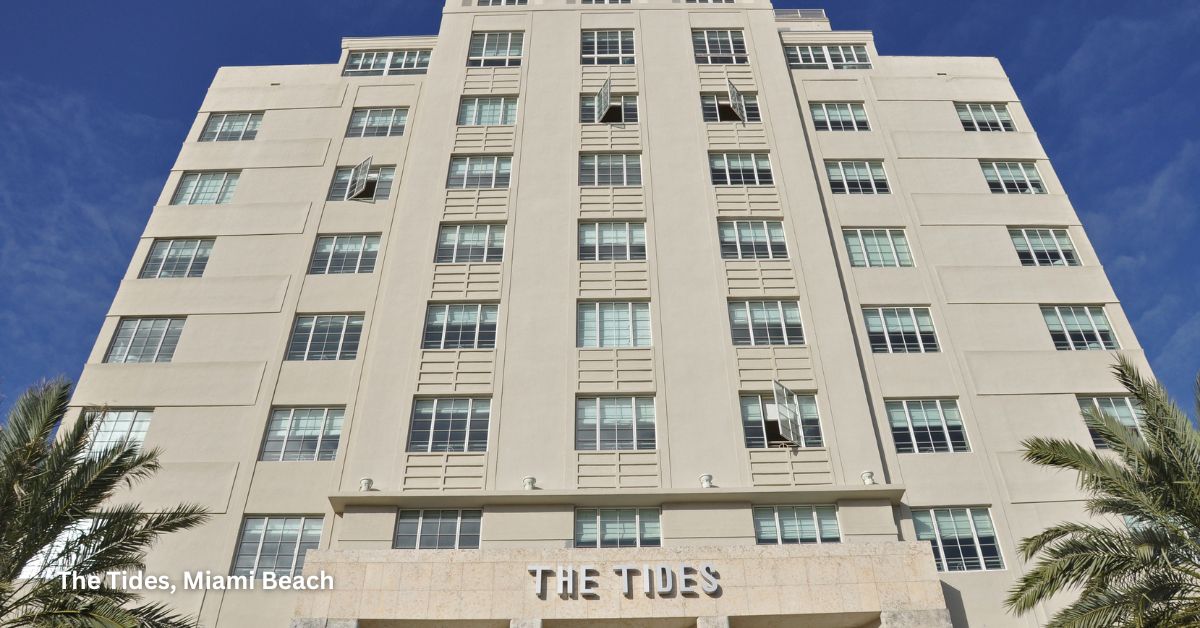
12. The Raleigh Hotel (1940) - 1775 Collins Avenue
Designed by L. Murray Dixon, The Raleigh is one of Miami Beach’s most celebrated Art Deco hotels, blending sleek architectural lines with vintage Hollywood glamour. Its cascading, curvilinear pool is a work of art in itself—so iconic that it has hosted fashion icons like Helmut Newton and runway events for Chanel. The hotel’s signature terrazzo floors, mahogany accents, and maritime-inspired design reflect the refined craftsmanship of the Deco era. Having served as a playground for celebrities and style-makers, The Raleigh continues to be a symbol of Miami’s enduring love affair with luxury, design, and the arts.
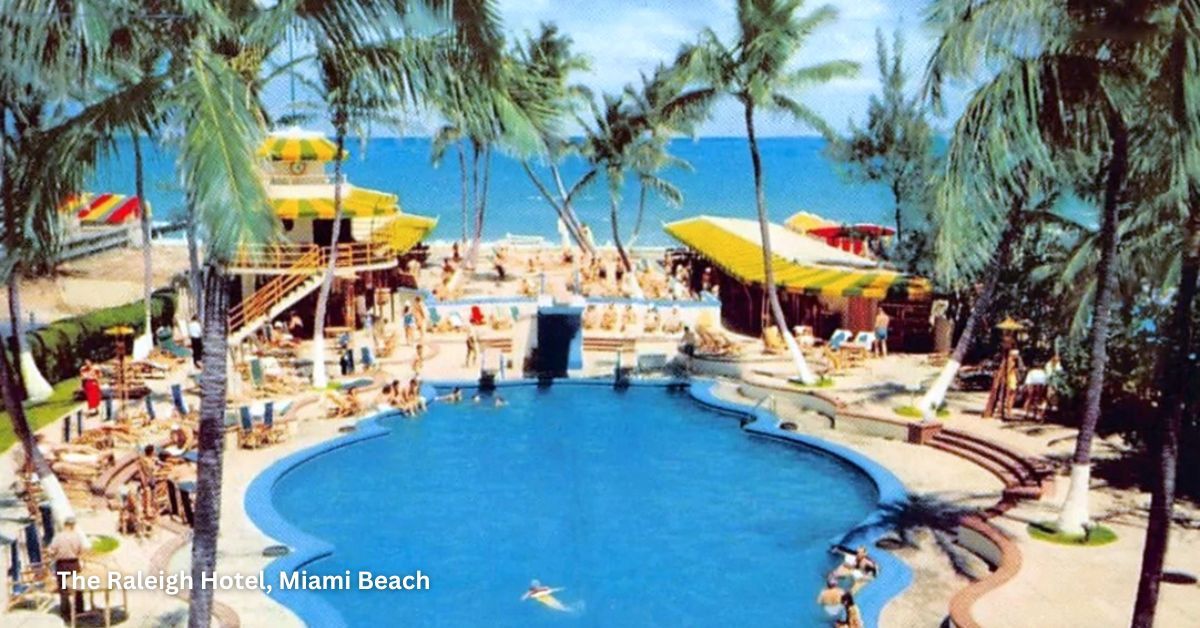
13. Delano South Beach Hotel (1947) - 1685 Collins Avenue
Originally Miami Beach’s tallest building, The Delano embodies minimalist Art Deco elegance. Its whitewashed facade, sleek lines, and striking vertical emphasis make it one of the most luxurious Deco hotels in South Beach. Designed by Robert Swartburg, the Delano has long been a favorite celebrity haunt, attracting A-listers to its iconic pool and rooftop lounges. Today, it remains a symbol of Miami’s enduring Deco glamor.
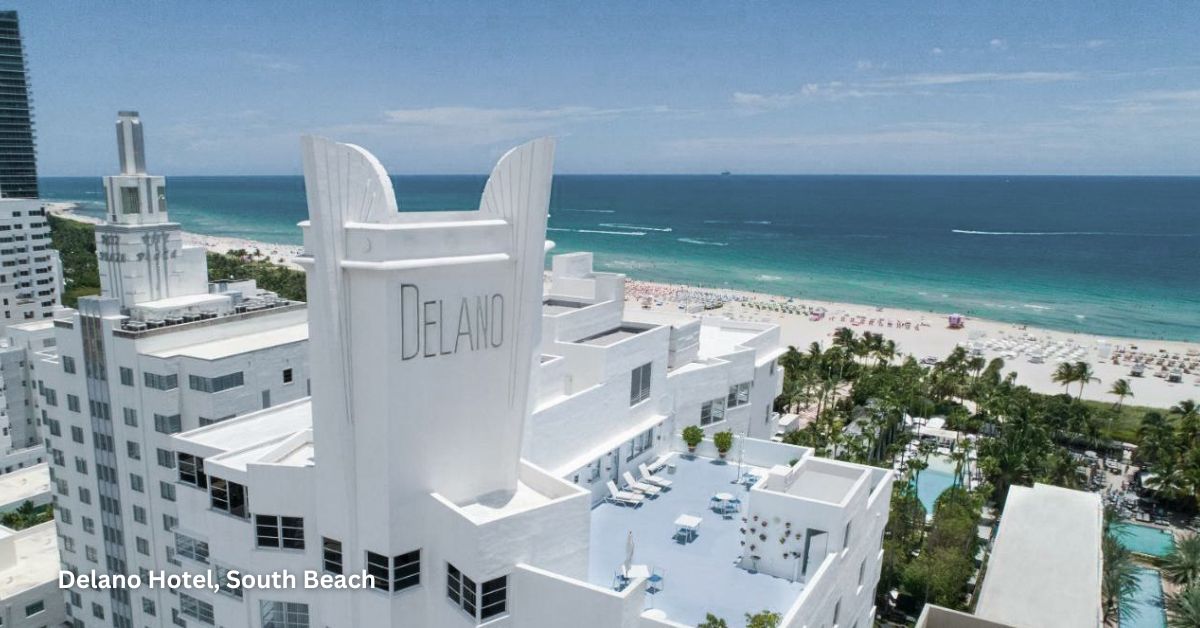
14. National Hotel (1939) - 1677 Collins Avenue
A grand example of Art Deco elegance, The National is best known for its 205-foot-long infinity pool, the longest in Miami Beach. Designed by Roy France, the hotel features sleek horizontal lines, strong vertical symmetry, and intricate terrazzo flooring. The interior retains many of its original Deco details, including vintage light fixtures and handcrafted furniture. Its oceanfront location and timeless sophistication make it one of Miami’s most distinguished Deco properties.
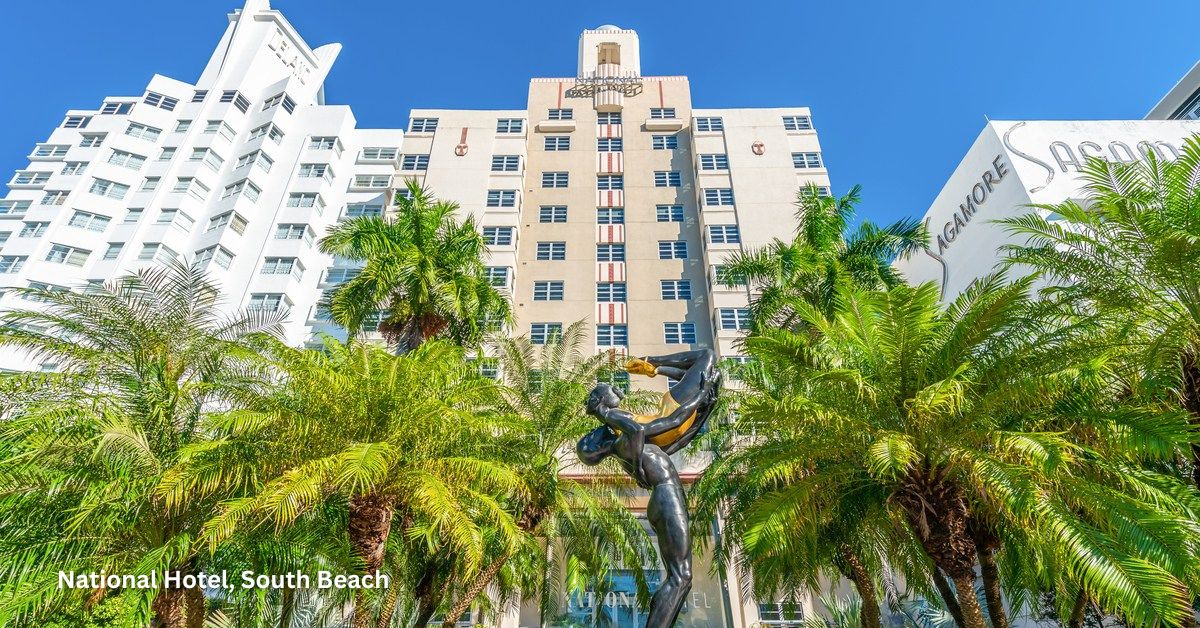
15. Park Central Hotel (1937) - 640 Ocean Drive
Nicknamed the "Blue Jewel" of Ocean Drive, the Park Central Hotel is a masterpiece of Henry Hohauser’s Art Deco vision, known for its bold cobalt-blue neon glow, sweeping curves, and maritime-inspired aesthetic. A favorite hideaway for Hollywood royalty like Clark Gable and Rita Hayworth, the hotel became a symbol of Miami’s Golden Age of Travel, when celebrities flocked to South Beach for its effortless glamour. Inside, the lobby’s rich terrazzo flooring and streamlined chrome accents preserve the hotel’s Deco-era elegance. While it has undergone updates, Park Central remains one of the most stunning examples of Miami’s oceanfront Deco legacy, capturing the timeless energy of South Beach nightlife.
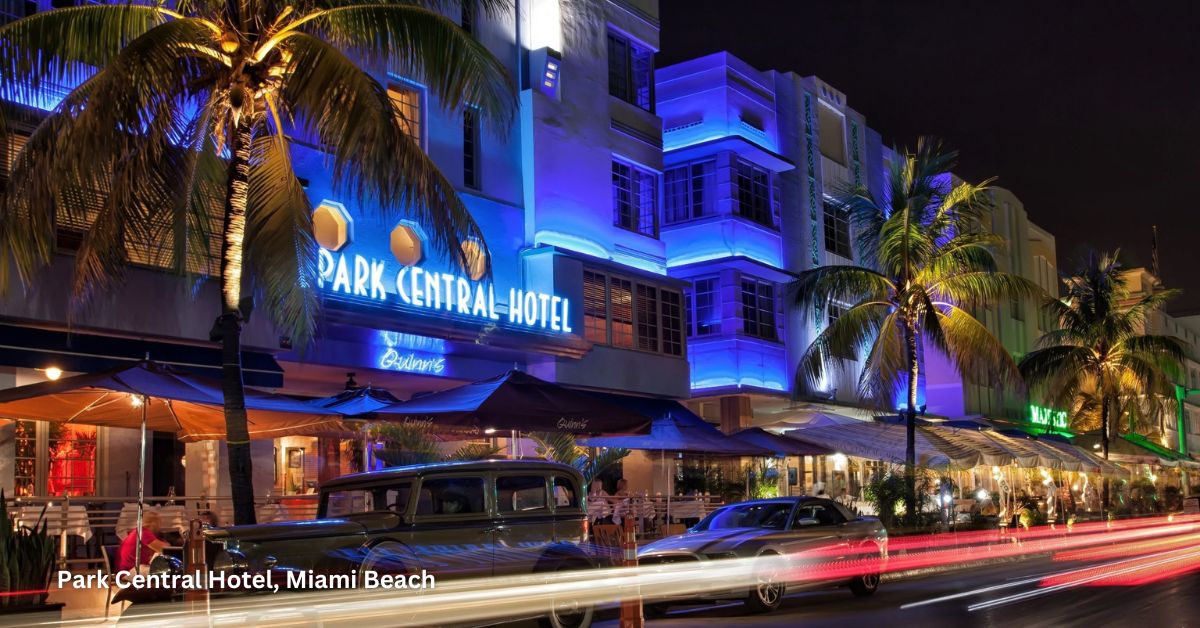
16. Leslie Hotel (1937) - 1244 Ocean Drive
With its signature sunny yellow facade, soft curves, and playful Deco details, the Leslie Hotel exudes the carefree, tropical charm of Miami’s Art Deco movement. Built during the height of Miami Beach’s booming resort culture, the Leslie was designed to bring a sense of lighthearted escapism, evident in its whimsical neon signage and stylized nautical elements. The rooftop pool and ocean-facing terraces have long attracted travelers looking for a blend of classic Deco elegance and beachfront relaxation. Today, the Leslie remains a standout among Ocean Drive’s Art Deco icons, embodying the warm, sun-drenched allure of South Beach’s golden age.
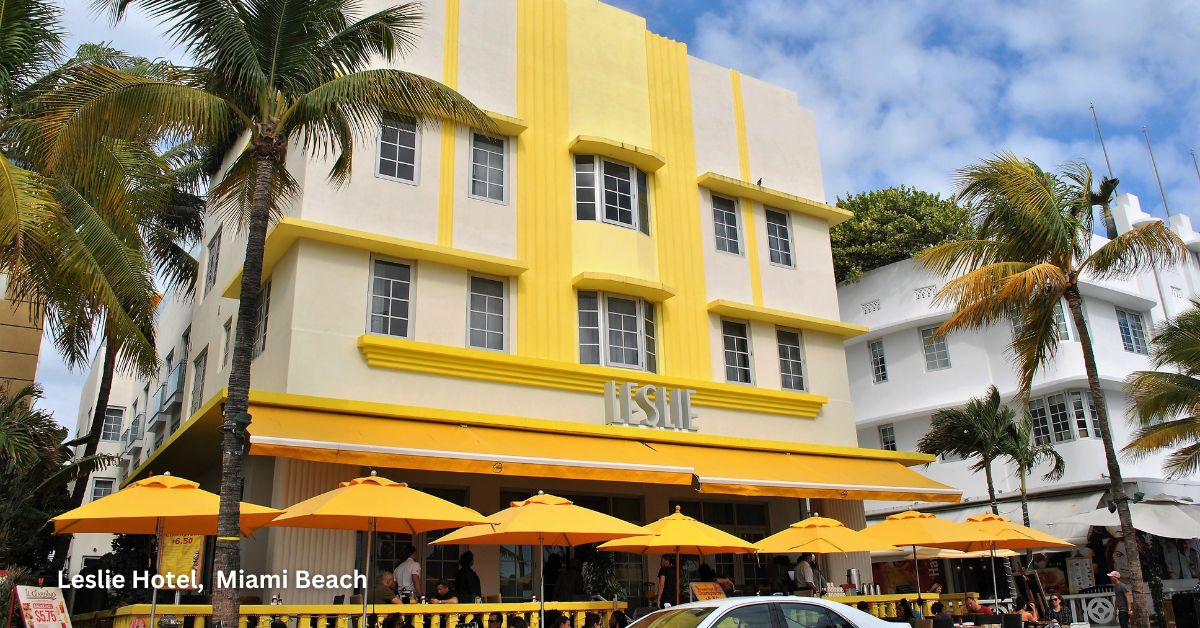
17. Cavalier Hotel (1936) - 1320 Ocean Drive
A one-of-a-kind Deco treasure, the Cavalier Hotel stands out with its Aztec and Mayan-inspired motifs—a striking contrast to Miami’s typical pastel-hued Deco. Designed to evoke a sense of adventure and exoticism, its intricately carved facade, stylized sunbursts, and earthy color palette give it an old-world grandeur unlike any other Art Deco property in South Beach. Step inside, and you’ll find an opulently detailed lobby with hand-painted ceilings, original terrazzo floors, and brass accents—a time capsule of the 1930s when Miami Beach was a rising cultural mecca. The Cavalier’s bold artistic elements make it a must-visit for Deco lovers looking to experience the more eclectic side of Miami’s architectural heritage.
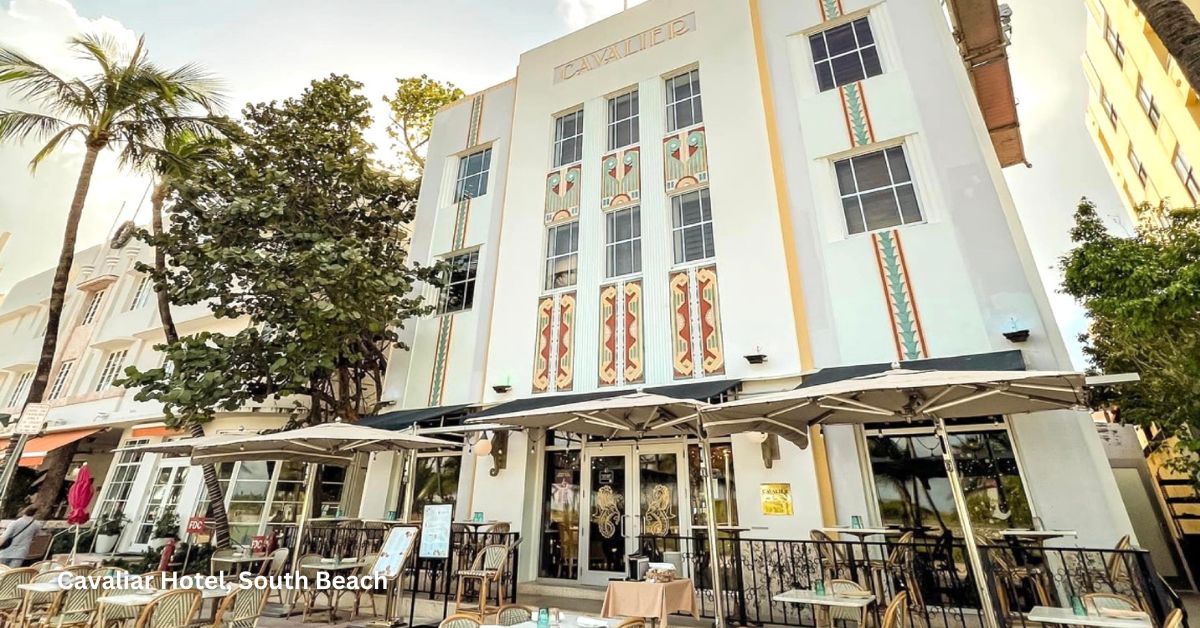
18. Breakwater Hotel (1939) - 940 Ocean Drive
The Breakwater Hotel is one of the most eye-catching landmarks on Ocean Drive, with its bold symmetry, glowing neon signage, and towering vertical fin. Designed by Anton Skislewicz, this hotel is a perfect example of Nautical Moderne, a subset of Art Deco that mirrors the sleek elegance of ocean liners. The building’s glass-block windows, chrome accents, and terrazzo flooring reinforce its futuristic 1930s design. Today, the Breakwater remains one of the most photographed structures in South Beach, especially at night when its electric blue and yellow signage illuminates the skyline.
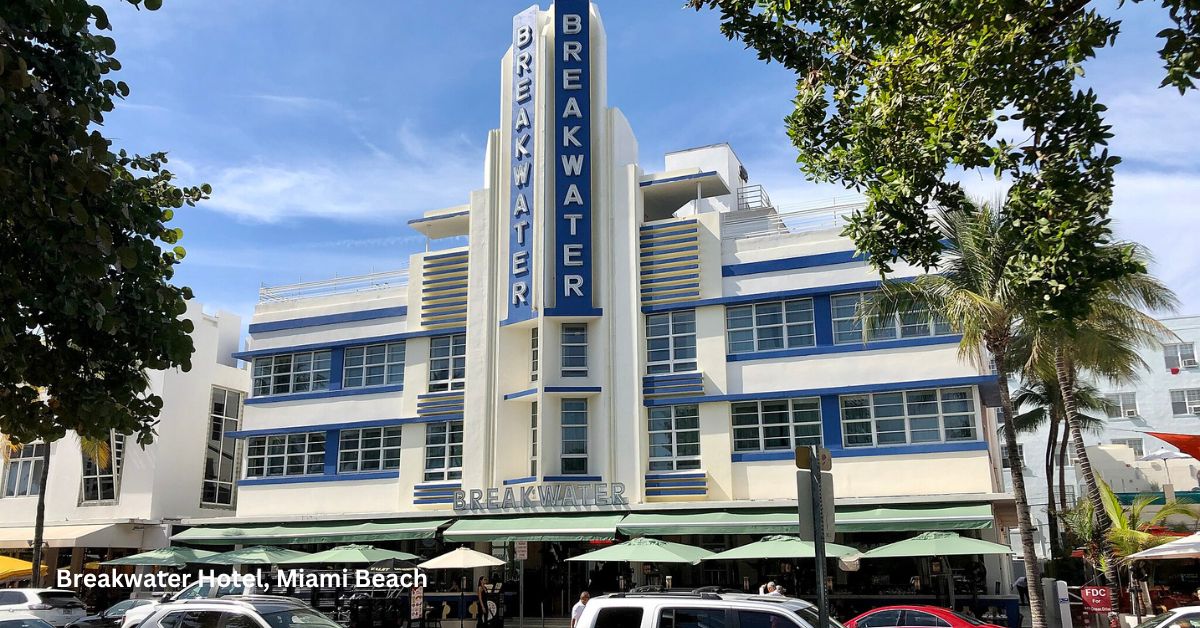
19. McAlpin Hotel (1940) - 1424 Ocean Drive
Designed by L. Murray Dixon, the McAlpin Hotel is a pastel-hued Deco dream, instantly recognizable for its flawless symmetry, soft pink and mint green facade, and signature neon signage. A quintessential example of Miami’s Tropical Deco style, the McAlpin’s porthole windows, horizontal bands, and sleek geometric details reflect the breezy elegance that defined South Beach’s architectural renaissance. Unlike some of its larger counterparts, this boutique gem offers an intimate charm, making it a favorite among photographers, design lovers, and travelers seeking a quieter Deco experience. Tucked between Ocean Drive’s high-energy hotspots, the McAlpin remains a visual masterpiece and a testament to Miami Beach’s artistic legacy.
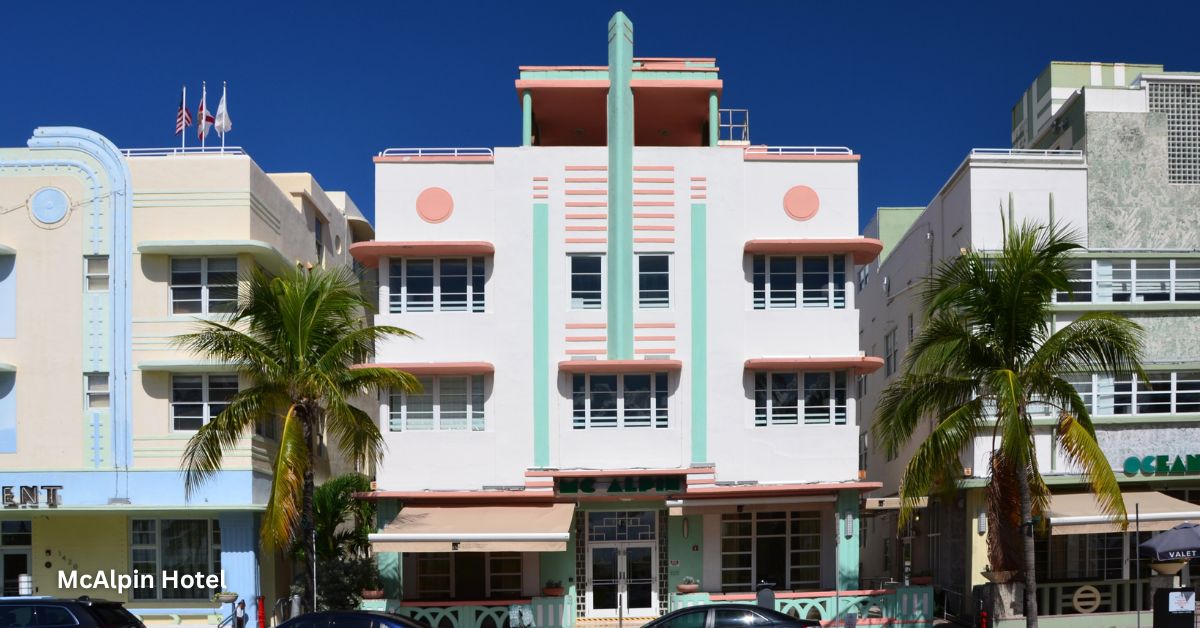
20. Marlin Hotel (1939) 1200 Collins Avenue
Designed by L. Murray Dixon, The Marlin Hotel stands out with its soft pastel facade, futuristic curves, and signature “eyebrows” that extend over the windows. While it retains its classic Deco charm, The Marlin is best known for its world-famous recording studio, where artists like Bob Marley, Jay-Z, and Pharrell Williams have produced music. Its subtle neon accents and sleek geometric design make it an architectural standout on Collins Avenue. The Marlin remains a favorite for those who appreciate both history and music, making it a unique stop on any Art Deco tour.
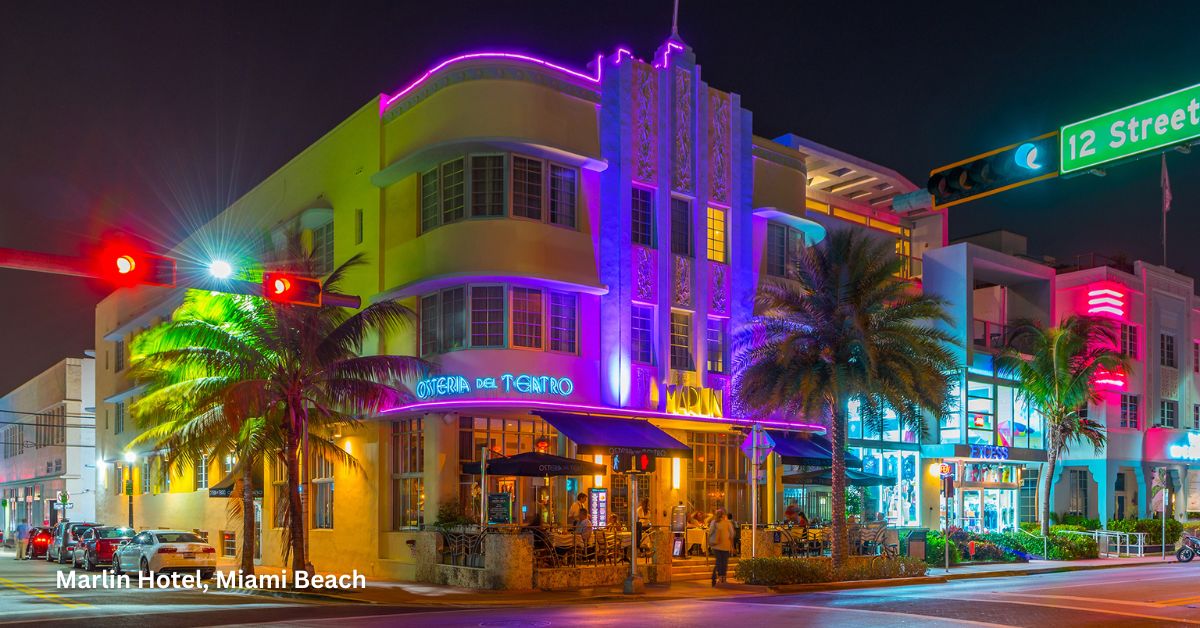
21 The Celino (1937) – 640 Ocean Drive
Formerly known as Park Central Hotel, The Celino is a Henry Hohauser masterpiece that embodies the glamour of Miami’s Art Deco golden age. The building’s bold vertical bands, curved glass-block windows, and signature “eyebrows” over its windows are hallmarks of Miami’s Tropical Deco style, inspired by the sleek lines of cruise ships. A favorite of Hollywood’s elite, the hotel hosted icons like Clark Gable, Carole Lombard, and Rita Hayworth, who brought old-Hollywood charm to Ocean Drive. The Celino’s interiors were once filled with hand-painted murals and terrazzo floors, a nod to the artistic craftsmanship of the era. Following a multimillion-dollar renovation, the hotel seamlessly blends Deco elegance with modern luxury, proving that Miami’s architectural legacy can still set the standard for style.
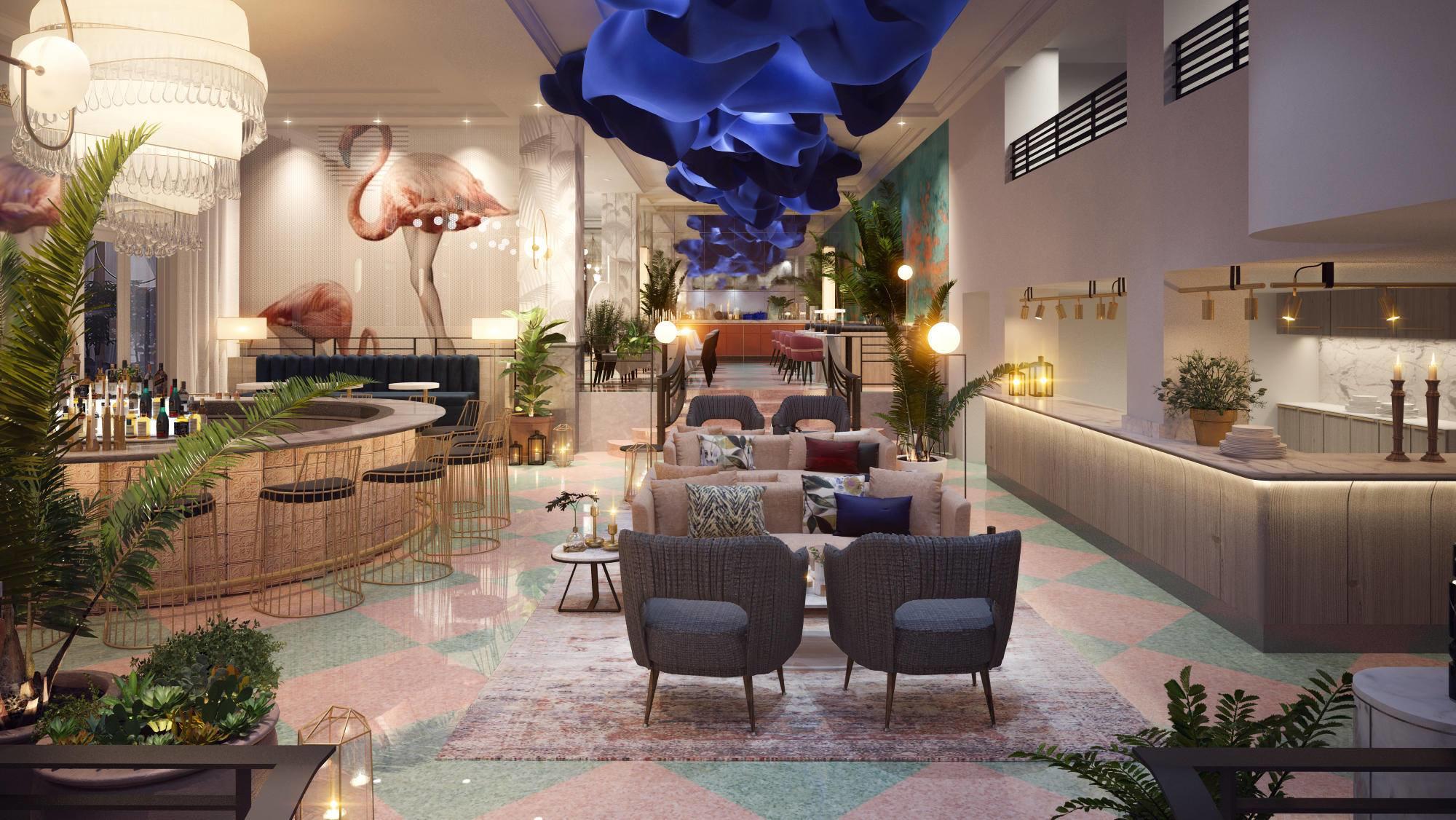
22 The Clevelander (1938) – 1020 Ocean Drive
More than just a hotel, The Clevelander is a cultural landmark where Art Deco meets Miami’s world-famous nightlife. Designed by Albert Anis, the building’s curved facade, neon glow, and sleek geometric accents encapsulate the city's breezy, tropical take on Deco design. In its heyday, the hotel’s sweeping terraces and bold signage helped define the energy of Ocean Drive, creating a backdrop for Miami’s evolving entertainment scene. While the rooftop bar and outdoor pool deck now take center stage, The Clevelander’s original terrazzo floors and intricate metalwork remain intact, showcasing the fine craftsmanship of the Art Deco movement. Today, it remains one of South Beach’s most electrifying nightlife destinations, proving that history and modern culture can thrive side by side.
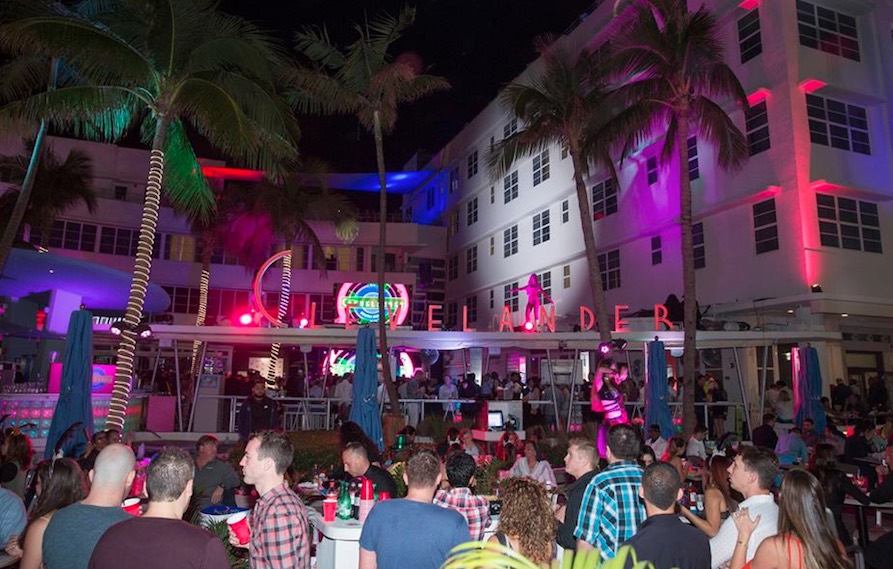
23 The Beacon South Beach Hotel (1936) – 720 Ocean Drive
One of the most photogenic Art Deco hotels on Ocean Drive, The Beacon radiates Miami’s signature Deco glamour with its brilliant neon accents, symmetrical facade, and chrome detailing. Designed by Henry O. Nelson, the Beacon’s uninterrupted horizontal bands and curved corners mirror the sleek forms of vintage automobiles and ocean liners, both major influences on Art Deco architecture. Over the years, the hotel has been a backdrop for countless films and TV shows, cementing its status as a cultural touchstone. The handcrafted glass panels and preserved terrazzo floors inside are subtle yet striking reminders of the artistry that defines the Deco era.
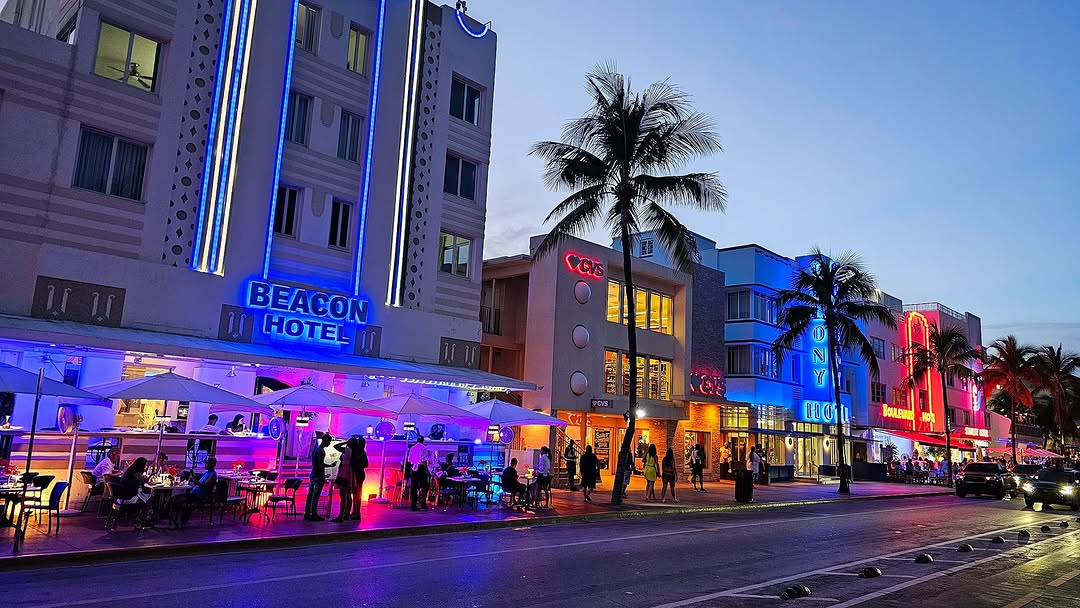
24 Art Deco Beach Patrol Headquarters (1934) – 1001 Ocean Drive
One of Miami Beach’s most distinctive Deco buildings, this nautical-inspired masterpiece was designed by Robert Taylor to house the city’s lifeguard operations. The long rows of porthole windows, curved corners, and streamlined railings were directly inspired by the cruise ships that once docked at the Port of Miami, creating a true fusion of function and artistic expression. Unlike many Deco buildings that have changed over time, the Beach Patrol Headquarters remains in use for its original purpose, making it one of the most authentically preserved Deco landmarks in Miami. Inside, the original terrazzo flooring and maritime-themed detailing remain untouched, reinforcing its place in Miami’s rich architectural and cultural history.
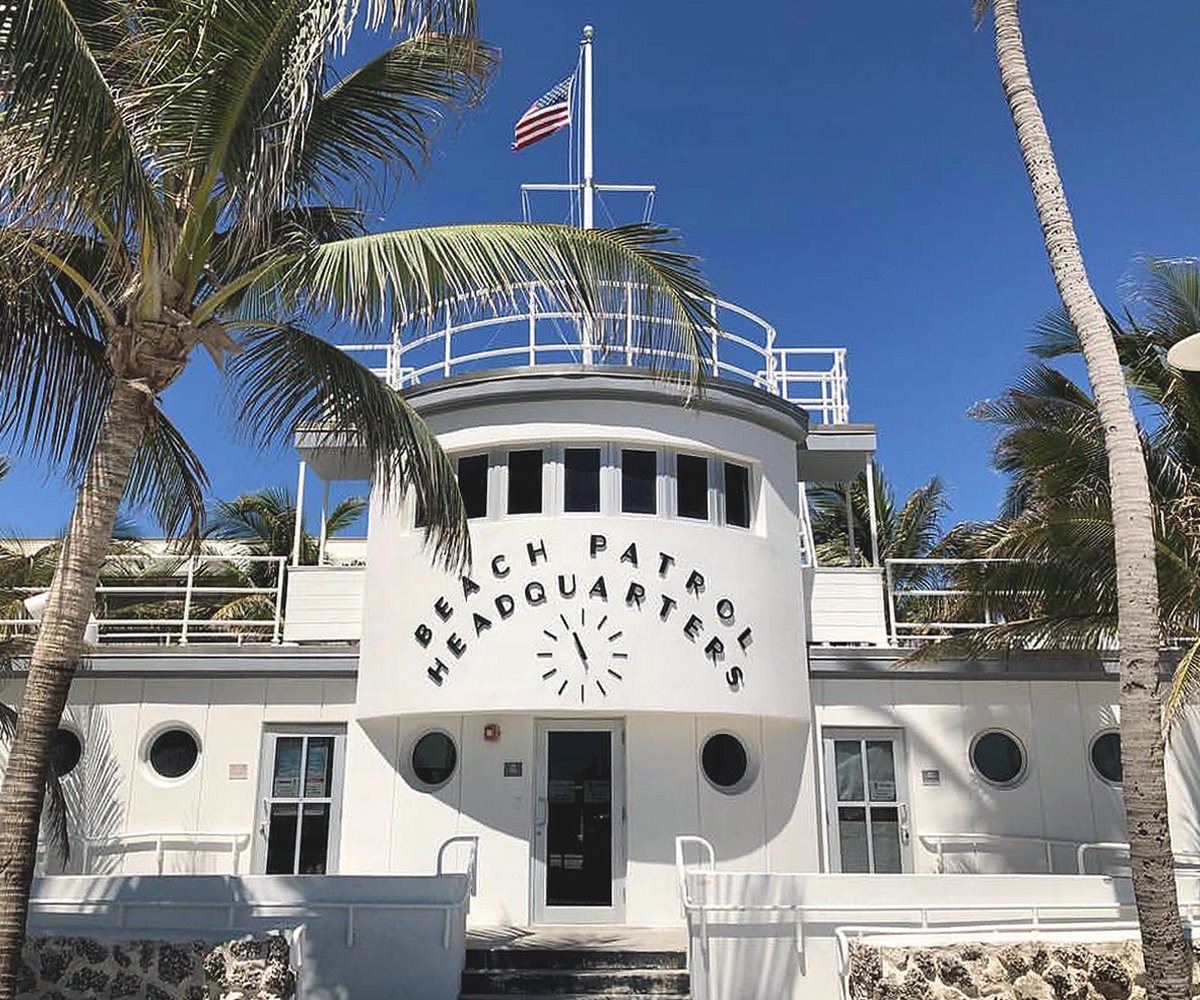
25 The Avalon Hotel (1941) – 700 Ocean Drive
Few Art Deco hotels capture the spirit of Miami Beach quite like The Avalon. Designed by Albert Anis, this pastel-hued gem is a time capsule of Deco-era elegance, complete with chrome accents, smooth geometric patterns, and its famous neon signage that glows at night. If you’ve ever seen a vintage car parked outside a hotel in Miami, chances are it was in front of The Avalon—a tradition that pays homage to the glitz and nostalgia of 1940s South Beach. The building’s bold horizontal lines and maritime-inspired design make it a true example of Tropical Deco, reflecting Miami’s blend of luxury and laid-back coastal style.
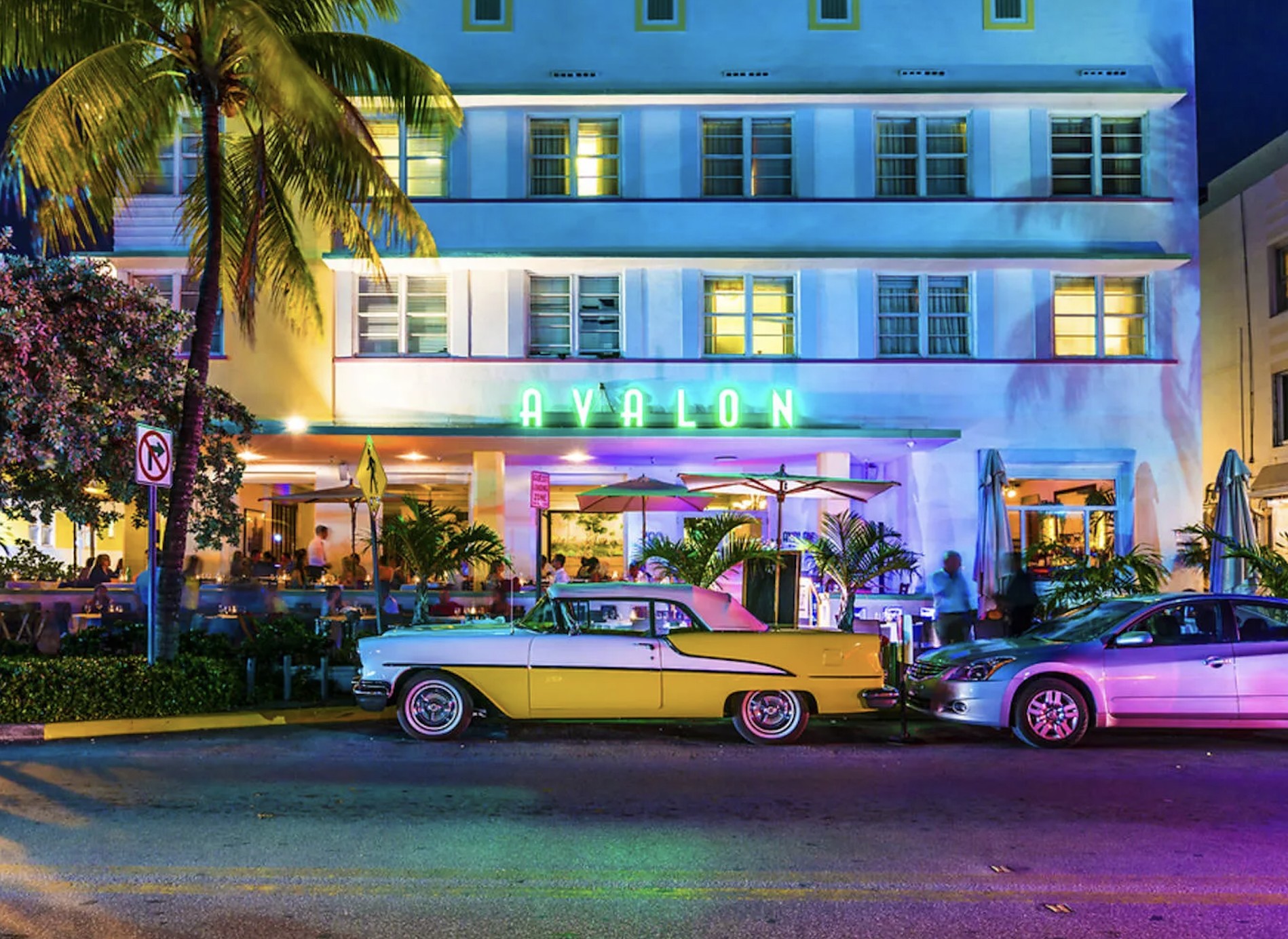
26 The Villa Casa Casuarina (1930) – 1116 Ocean Drive
Arguably one of the most famous homes in Miami, The Villa Casa Casuarina—better known as the Versace Mansion—is an exquisite blend of Mediterranean Revival and Art Deco elegance. Originally built as an apartment complex, the mansion took on a new life when fashion icon Gianni Versace purchased it in 1992 and transformed it into a lavish private estate. While not a pure Deco building, its geometric tilework, symmetrical patterns, and lavish gold detailing reflect the movement’s influence. The mosaic-filled courtyard and grandiose interiors now function as a boutique hotel, giving guests an exclusive glimpse into one of Miami’s most extravagant and culturally significant properties.
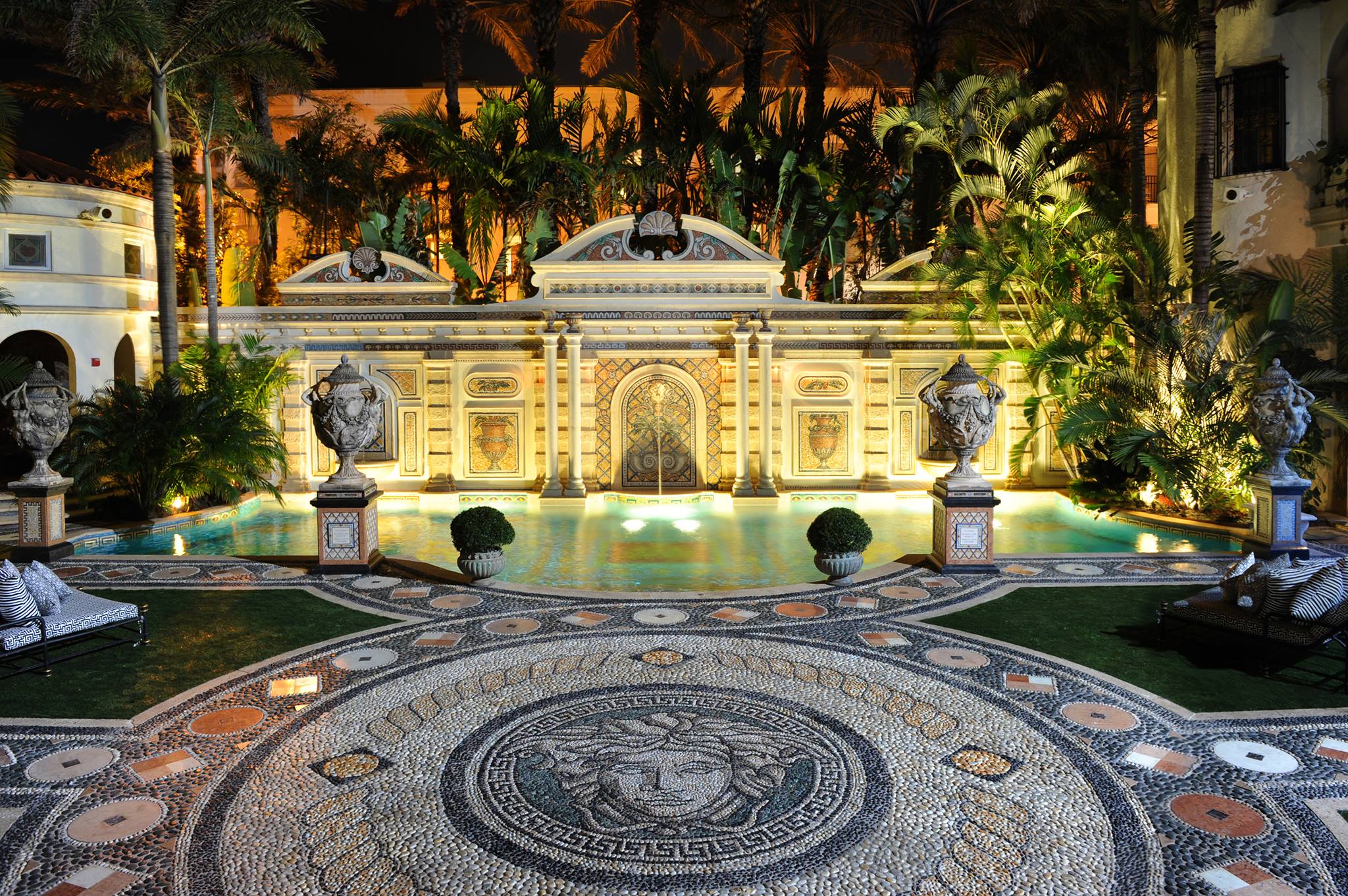
27 The Cameo Night Club (1938) – 1445 Washington Avenue
Originally a Deco-era movie palace, The Cameo later transformed into one of Miami’s most legendary nightclubs, playing a central role in the city’s music and nightlife scene. Designed with bold neon signage, a towering marquee, and sleek symmetrical lines, the building still exudes its cinematic roots. Over the decades, it has hosted some of the biggest DJs and live music acts, making it a staple of Miami’s electronic and hip-hop culture. Though its purpose has evolved, The Cameo remains an unmistakable Art Deco treasure, proving that even nightlife venues can be architectural works of art.
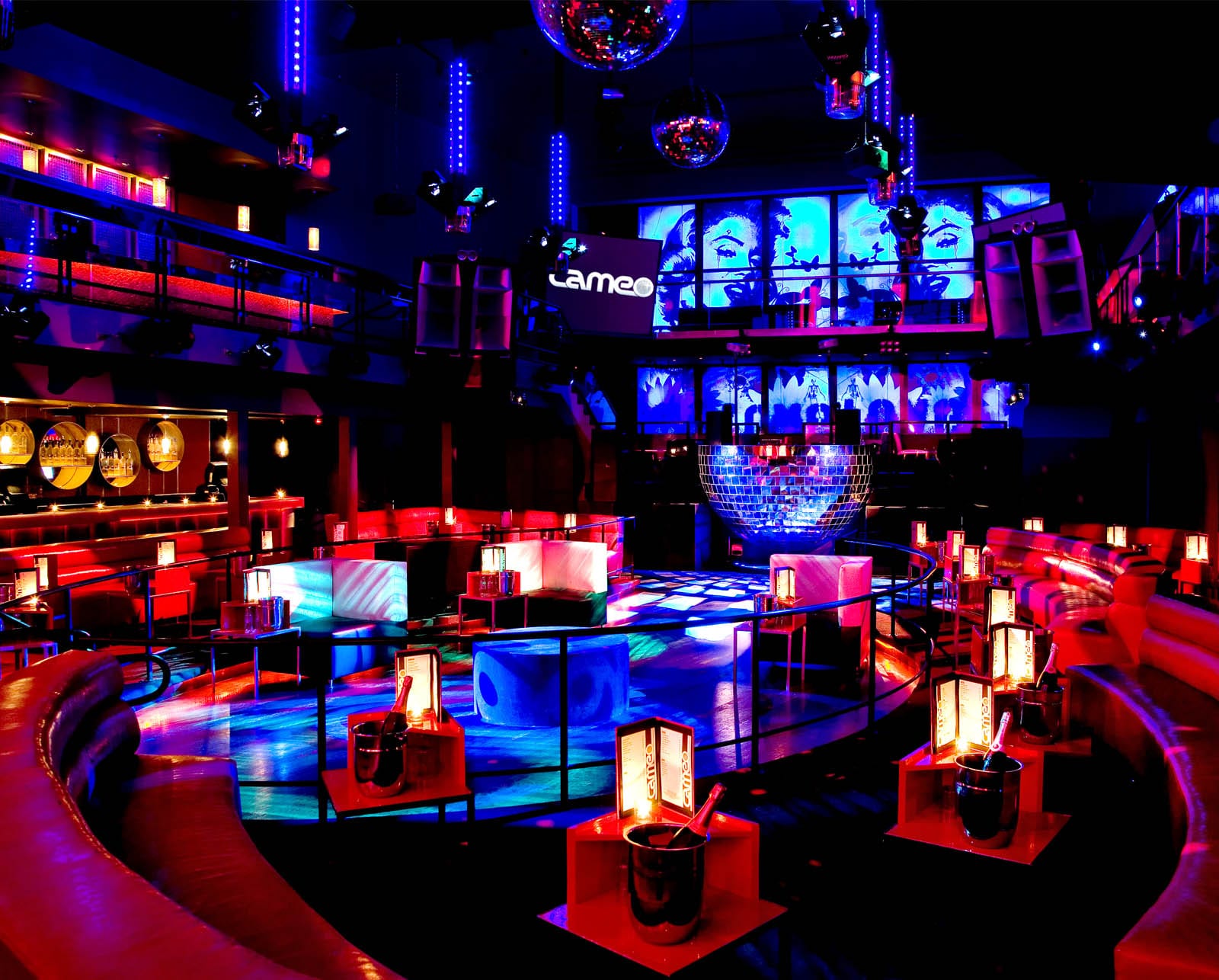
28 Hoffman’s Cafeteria (1939) – 1450 Collins Avenue
A true Deco gem by Henry Hohauser, Hoffman’s Cafeteria is one of the most visually striking buildings in Miami Beach. Its sweeping "angel wing" facade, central turret, and smooth curved lines make it an unforgettable sight along Collins Avenue. Once a bustling cafeteria, then a famed nightclub, its walls have witnessed decades of Miami’s cultural evolution. Though it has housed various businesses over the years, the building’s original Deco details—terrazzo floors, geometric glass windows, and chrome accents—have been carefully preserved, making it a living piece of Miami Beach history.
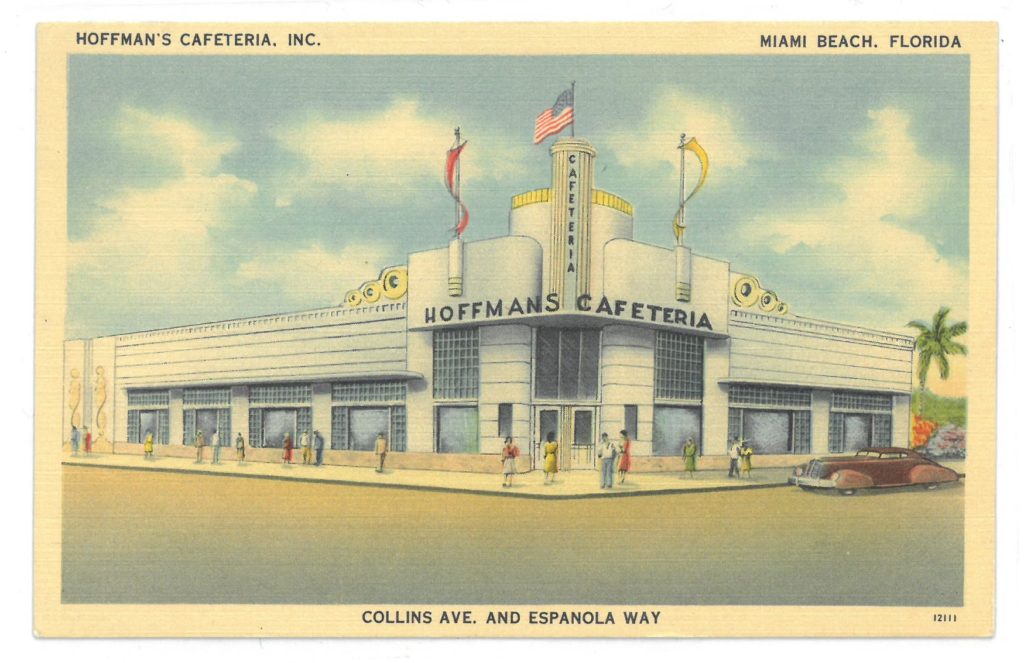
Miami isn’t just home to the world’s largest collection of Art Deco architecture—it’s a city shaped by its bold, cinematic aesthetic. The sleek lines, geometric patterns, and neon glow that define its skyline have done more than preserve history; they’ve inspired entire creative movements. From the silver screen to contemporary art, Art Deco’s influence pulses through Miami’s cultural identity, making it a backdrop for filmmakers, designers, and visionaries alike. It’s no surprise that some of Miami’s most famous film locations feature these iconic landmarks, blending history with pop culture. Its legacy isn’t just about the past—it continues to fuel Miami’s artistic evolution in ways still unfolding.

